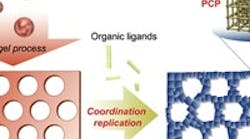A process described as "reverse fossilization" produces porous structures capable of high efficiency separations, report researchers at the WPI Institute for Integrated Cell-Material Sciences at Kyoto University, Kyoto, Japan.
The process (Figure 1) starts with the creation of a mesoscopic-size shaped mineral template via a sol-gel process. Through the action of organic ligands, porous coordination polymer (PCP) crystals replace the metal oxide (the researchers used alumina), retaining the lattice structure. The PCP crystals contain both organic and mineral components.
"After creating the alumina lattice, we transformed it, molecule for molecule, from a metal structure into a largely non-metallic one — hence the term 'reverse fossilization,' taking something inorganic and making it organic, all while preserving its shape and form," explains Associate Professor Shuhei Furukawa, the team leader.
After succeeding in making both two- and three-dimensional test architectures, the researchers transformed alumina aerogels with highly open, sponge-like structures to test the resultant PCP-based materials' performance in separating water and ethanol. One material, dubbed Meso-PCP, contained mesopores with a median size of 94 nm, while the other, called Macro-PCP, had both mesopores (38 nm) and macropores (1 µm).
"Water/ethanol separation has not been commonly possible using existing porous materials," notes team member Dr. Julien Reboul. "The PCP-based structures we created, however, combine the intrinsic nano-level adsorptive properties of the PCPs themselves with the meso- and macroscopic properties of the template aerogels, greatly increasing separation efficiency and capacity."
The Meso-PCP provided a 2.56 water/ethanol separation selectivity versus 1.84 for the Macro-PCP. However, the Macro-PCP afforded a shorter separation time and a lower pressure at the inlet of the separation column, 33 kPa compared to 54 kPa for the Meso-PCP — and 256 kPa for a conventional PCP powder packed in the column, says Reboul. More details appear in a recent article in Nature Materials.
The low density and high porosity of the structures might raise concerns about their fragility, he admits. However, in the experiments the PCP materials were repeatedly used at temperatures up to 120°C and pressures as high as 250 kPA at the inlet of the separation column without any loss of performance, he notes, adding that mechanical properties can be improved, if required, by optimizing the alumina parent-phase structure.
The researchers now are working to optimize the alumina-based material for ethanol/water separation. In addition, they are exploring the use of metal oxides other than alumina, and the potential of the mesoscopic structures as adsorbents for other gas- and liquid-phase separations, such as removal of volatile organic compounds from water, and as catalysts, says Reboul.
"The chemical nature of the organic ligand used to perform the coordination replication method determines the pore characteristics of the constructed PCP architectures. Hence, the careful selection of the organic ligand… should enable us to tune the type of sorption selectivity of our material, making it suitable for the targeted separations," he explains.

